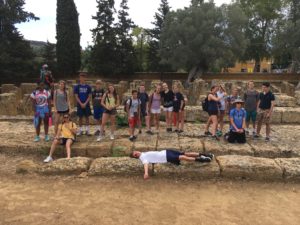Today is our second day in Siracusa (Syracuse), and yesterday evening we walked through the oldest portion of the city called Ortigia. We stopped for several minutes and talked about the Temple of Apollo that was built by the Greek colonists in the 700s BC. Apollo’s temple here was considered to be the first Doric temple built out of stone in the whole Greek world (in fact Greek colonies in Sicily led the way into stone-built temples before Greek city-states around the Aegean). When asked by Dr. Pollio what architectural innovations this temple exhibited, the students identified several details. First, the columns are monolithic instead of being constructed from drums of stone stacked together. Additionally, the builders were conservative in their spacing of the columns, reflecting an uncertainty in the carrying capacity of their materials. Other early temples (like the one honoring Hercules in Agrigento) have similar small spacing between the columns compared with later temples. The visible development of temple building is a good reminder that in the ancient world, people pushed their boundaries of what was possible.
Two days ago we walked up the ridge in Agrigento known as the Valley of Temples (why it’s called a valley is beyond us). We began our walk at the bottom of the valley among several temples dedicated to the chthonic gods- those dealing with earthly matters like Demeter and Hestia. The design of the temples and the chronology of their construction show how the people of Agrigento’s attention began with their immediate, earthly concerns and then grew to include the Olympic gods. The builders worked their way up the ridge building as they went.
Just above the chthonic area is a temple to Hercules. It is an early temple (evidenced by its construction). Then a huge temple built to honor Zeus. Although only the foundation is intact, the monumental size of the temple is evident. Huge columns carved in the figure of Atlas survive as does the foundation for the large altar outside the temple’s entrance.
As we continued our walk up the hill we saw the Temple of Concordia (later converted into a church, which contributed to its excellent preservation) and a temple dedicated to Hera at the top of the ridge.
The development and building on the ridge are reminders that even in antiquity, the Greeks felt pressure to push onwards, to grow, and to aspire to new things. Yesterday we were at Neapolis, which was an ancient Greek city built just outside Siracusa. It overlooks the Great Harbor where the Athenian expedition met its demise during the Peloponnesian War. As we walked through the quarry in which the thousands of Athenian captives were worked to death as slaves, Dr. Pollio and I impersonated Nicias and Alcibiades to reenact the debate over sending the Athenian expedition during the War.
Alcibiades was a brash, young, handsome Olympic Champion arguing that Athens should extend itself and push to expand its empire. Nicias was the elder statesman and argued that Athens should be wary of extending itself instead arguing that restoring order and strength at home was more important. The story of the rivalry between them is fascinating, but Alcibiades carries the day in the debate. The decision is a fateful one and ultimately leads to the Athenian fall from the top of the Greek world. All this raises the important question of knowing how to push oneself without going too far. For this the Greeks would need to turn to philosophy for wisdom about how to live and rule and avoid the dangers of demagoguery in a democracy.

